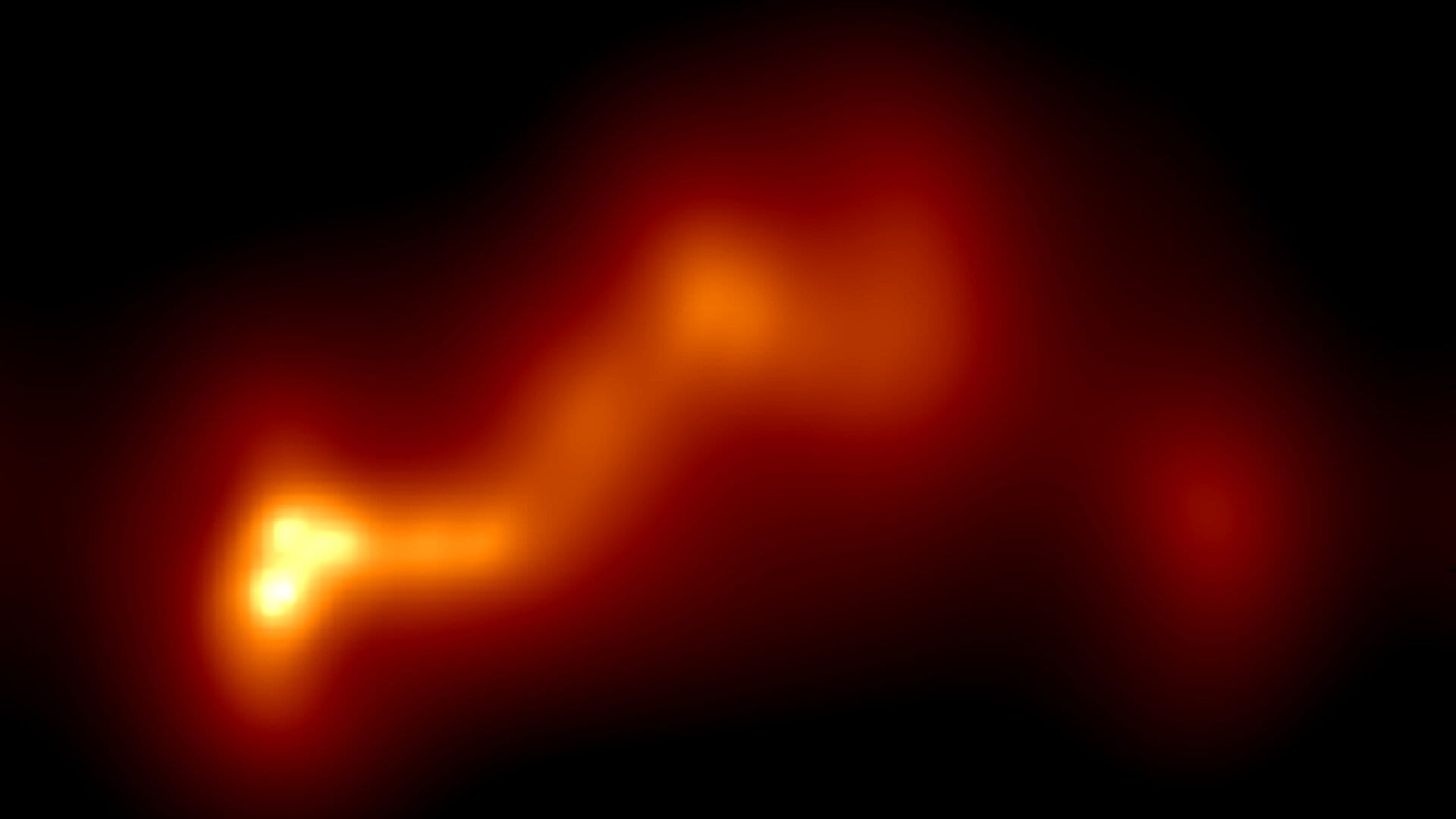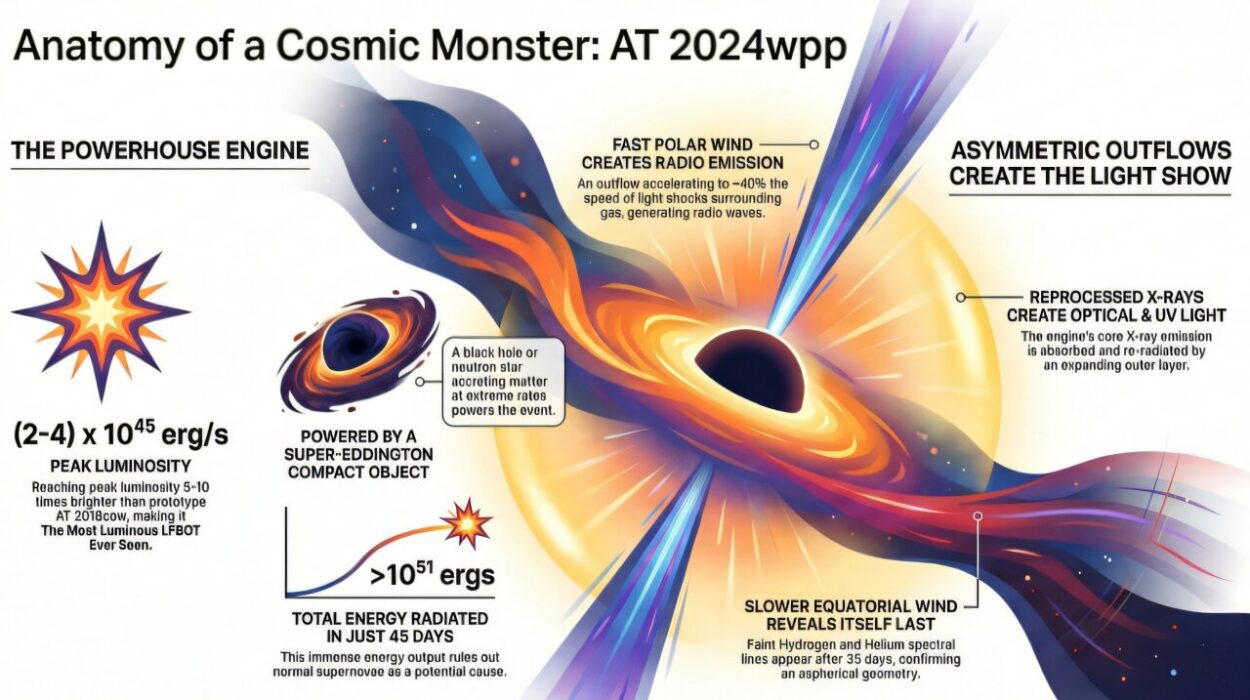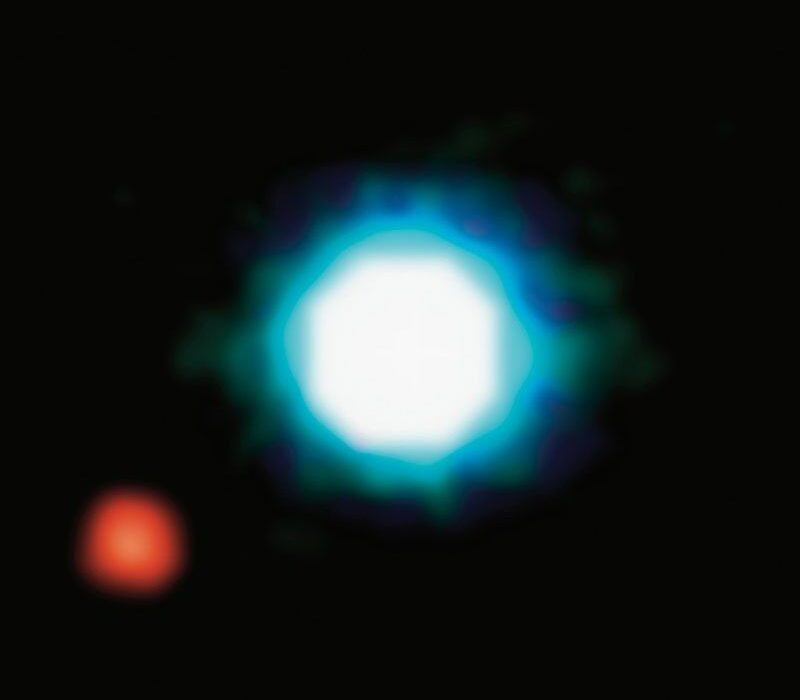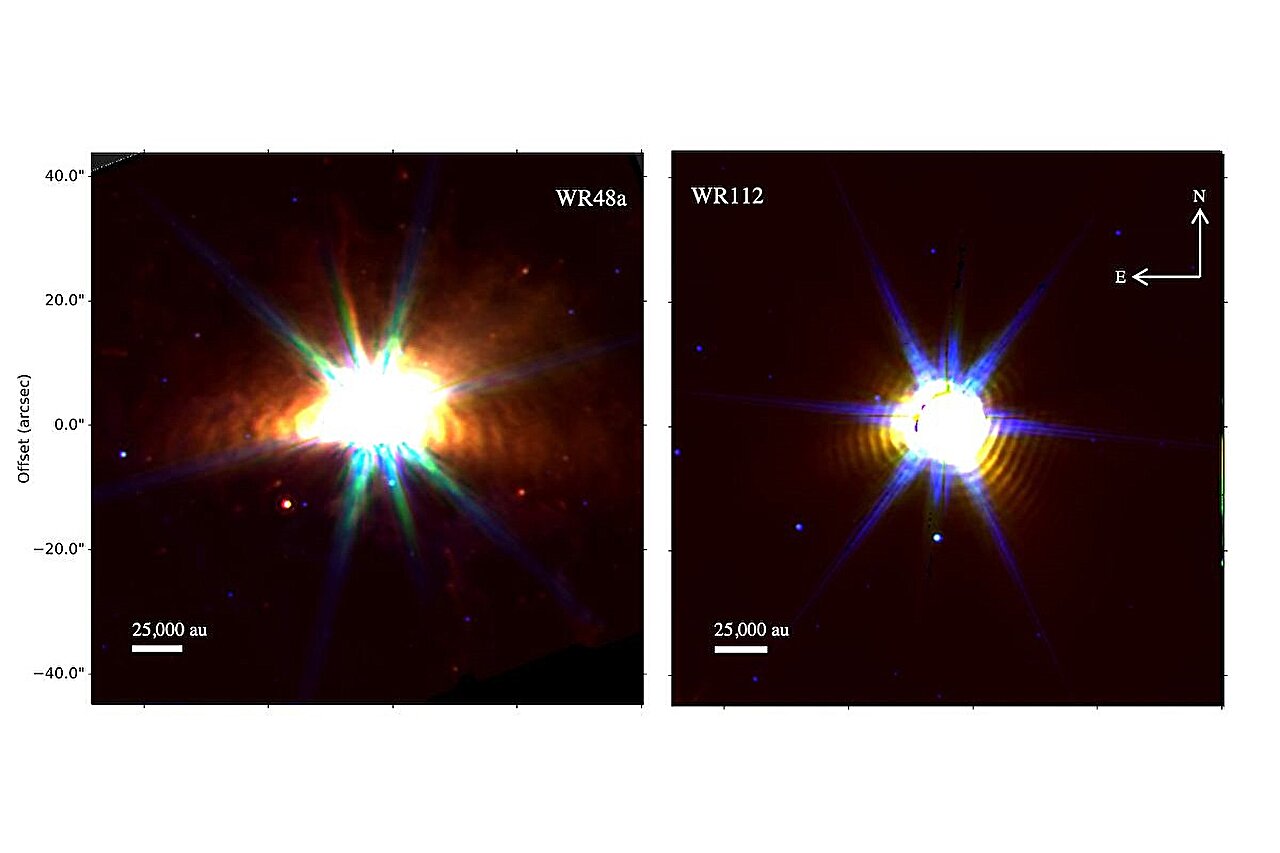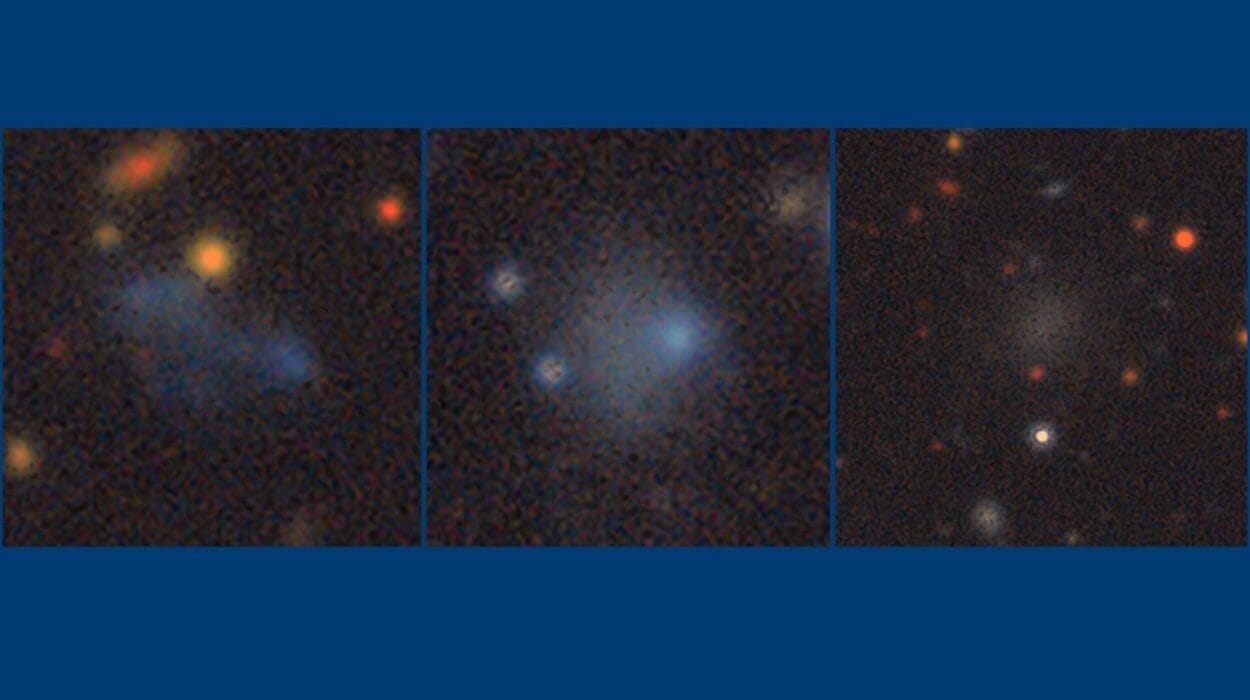For more than a century, the distant galaxy OJ 287 has baffled astronomers with its flickering brilliance and rhythmic outbursts of light. Located five billion light-years away in the constellation Cancer, this galaxy’s mysterious heartbeat—brightening and dimming like a cosmic metronome—has long hinted at something extraordinary lurking in its core. Now, for the first time, astronomers have captured a strikingly detailed image of the galaxy’s center, revealing a twisting jet of plasma that offers new clues to one of the most powerful and elusive phenomena in the universe: the merging of two supermassive black holes.
Led by Dr. Efthalia Traianou of Heidelberg University, an international team of researchers used a global network of radio telescopes—anchored by a space-based antenna orbiting Earth—to peer deeper into OJ 287 than ever before. The result is a stunning radio image that reveals a sharply curved, ribbon-like jet of plasma spiraling away from the galactic nucleus. It’s a discovery that not only confirms long-standing suspicions about a colossal black hole duo but also sheds light on the extreme environments surrounding these gravitational giants.
The team’s findings, published in the journal Astronomy & Astrophysics, represent a technological and scientific breakthrough in the study of active galactic nuclei—galaxies powered by black holes so massive and energetic that they outshine the billions of stars around them.
A Blazing Heart Shaped by Black Holes
OJ 287 belongs to a rare class of galaxies known as blazars—galactic cores that shoot intensely focused jets of energy and matter in the direction of Earth. These jets, formed as material spirals into the black hole and is ejected along magnetic field lines at near-light speeds, are among the most powerful phenomena in the universe. But OJ 287 has stood out for another reason: its puzzling, nearly periodic brightening, observed since the late 1800s. Scientists have long speculated that this behavior is caused by a pair of supermassive black holes in a cosmic dance, with one orbiting the other in a way that periodically disturbs the surrounding matter, triggering luminous outbursts.
Until now, direct visual evidence for such a binary system remained elusive. The newly released image changes that.
Peering into the Abyss with a Virtual Telescope Larger than Earth
The image was captured using a technique known as radio interferometry, which links multiple radio telescopes across vast distances to function as a single, enormous instrument. The keystone of the observation was the RadioAstron mission—a Russian space-based radio telescope launched aboard the Spektr-R satellite. With its 10-meter antenna circling the Earth, combined with 27 radio observatories scattered around the globe, the researchers effectively created a virtual telescope five times the diameter of Earth itself.
This extraordinary resolution allowed the team to see what no one had seen before: a section of OJ 287’s plasma jet that is not just emerging from the core but bending dramatically in space. It’s a curvature so pronounced, it suggests intense gravitational and magnetic influences—likely from the binary black hole system at the galaxy’s center.
“We have never before observed a structure in the OJ 287 galaxy at the level of detail seen in the new image,” said Dr. Traianou, a postdoctoral researcher in the team of Dr. Roman Gold at the Interdisciplinary Center for Scientific Computing of Heidelberg University. “This allows us to explore physical conditions near the black holes that are otherwise impossible to detect.”
Temperatures Beyond Comprehension
What lies within the jet is as fascinating as its shape. The radio signals reveal plasma regions exceeding ten trillion degrees Kelvin—temperatures vastly hotter than the core of our Sun and difficult to explain through conventional astrophysical mechanisms. Such temperatures suggest that particles are being accelerated to near the speed of light by intense magnetic fields and shock waves erupting near the black holes.
These jets are not just streams of particles; they are high-energy highways transporting radiation, atomic nuclei, and magnetic energy across intergalactic space. Understanding how they form and behave can unlock answers to how black holes influence their host galaxies and regulate star formation.
The researchers also identified the development and propagation of a shock wave within the jet—a ripple of high-energy disturbance moving outward. This shock wave is thought to be tied to a dramatic gamma-ray event detected from OJ 287 in 2017, involving energy in the trillion-electron volt (TeV) range. Such collisions and energy surges likely occur when fast-moving material in the jet crashes into slower-moving gas ahead of it, releasing bursts of radiation visible even from Earth.
Clues to a Binary Black Hole System
The newly imaged jet provides more than aesthetic astonishment—it offers tangible evidence for the presence of not one but two supermassive black holes locked in a gravitational embrace. One of the key consequences of such a system is the warping and reorientation of plasma jets, as the orbital motion of the black holes tugs on the surrounding matter and twists magnetic fields.
The shape of the jet in the new image matches simulations of what would happen if a secondary black hole periodically plunged through the accretion disk—the swirling, superheated ring of gas that feeds the larger black hole. Each collision would send shockwaves rippling through the jet and momentarily brighten the galaxy, explaining the periodic flares observed over the last century.
Its special properties make OJ 287 a prime candidate for future studies of gravitational waves—the ripples in spacetime predicted by Einstein and first directly observed in 2015. Though gravitational waves from stellar-mass black hole mergers have been detected, signals from supermassive mergers remain elusive. OJ 287 could be the first place where we detect them.
A Global Collaboration in Pursuit of the Extremes
The achievement is the result of years of collaboration across continents. Institutions from Germany, Italy, Russia, Spain, South Korea, and the United States contributed to the effort, bringing together diverse expertise in radio astronomy, high-energy astrophysics, and theoretical modeling.
The implications go far beyond OJ 287. By studying how plasma jets behave in the presence of a dynamic, possibly merging black hole pair, scientists can refine their understanding of how galaxies evolve and interact with the cosmos. Since supermassive black holes are thought to reside at the center of nearly every large galaxy, including our own Milky Way, the insights gleaned from OJ 287 could illuminate the past and future of our own galactic home.
Rewriting Einstein’s Universe, One Jet at a Time
The extreme gravity, heat, and motion at the center of OJ 287 are the very environments where the predictions of Einstein’s General Relativity—and its modern extensions—are pushed to the limit. The warped space-time near merging black holes is unlike any other place in the universe. By capturing the shape and behavior of the plasma jet, scientists are effectively mapping the contours of gravity itself.
It’s a fitting development in a century shaped by Einstein’s ideas. Just as his theories upended our notions of space and time, the latest observations of OJ 287 challenge our understanding of how black holes interact and evolve.
As radio telescopes become more sophisticated, and as next-generation observatories like the Square Kilometre Array and space missions such as the Event Horizon Telescope continue to mature, astronomers hope to observe more such galaxies in exquisite detail. OJ 287, with its blazing heart and twisted jet, stands as a beacon—pointing the way toward the most violent and mysterious processes in the cosmos.
Reference: E. Traianou et al, Revealing a ribbon-like jet in OJ 287 with RadioAstron, Astronomy & Astrophysics (2025). DOI: 10.1051/0004-6361/202554929
